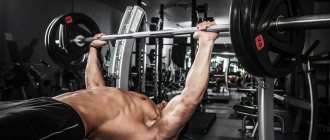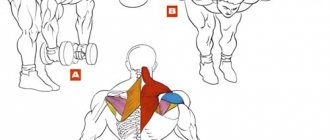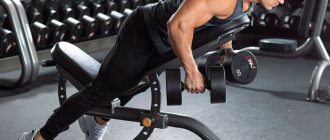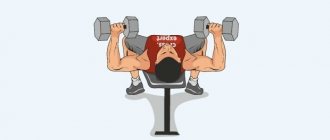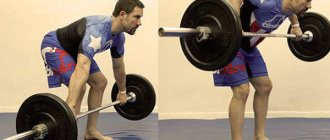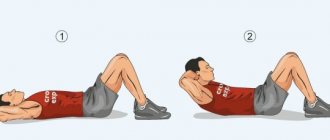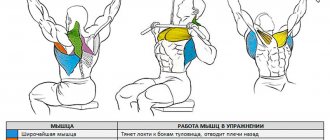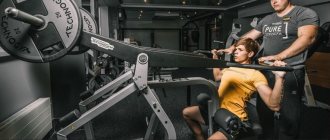Raising your arms with dumbbells while lying on a horizontal bench is one of the additional exercises for building the pectoral muscles. It is aimed at stretching the pectoralis major muscles. Arnold Schwarzenegger himself performed this isolation exercise in every chest workout. Let's look at the importance and features of this seemingly simple and ineffective, compared to basic, exercise.
What's happened
Lying dumbbell flyes, or dumbbell flyes, are a basic exercise. From the name it’s easy to guess that during it the athlete spreads his arms with dumbbells in different positions. You can do it lying on a bench with different inclination angles. The exercise uses several muscles and joints. It is useful to include it in chest training at the end of the set.
Increased efficiency
What other nuances need to be taken into account when starting to perform dumbbell lateral raises:
- What is important here is the small mass of the projectile, and the emphasis on the effort on the target muscles. The exercise does not initially involve increasing the load to record weights.
- You need to learn to control the position of your elbows. Throughout the entire series they maintain the same bend angle, looking straight at the floor at the lowest point.
- The bench is selected in height so that the thighs form a parallel with the floor, and the entire surface of the feet rests on it. Otherwise, the lower back arches more than necessary, increasing the load on the spine.
- The exercise is performed strictly synchronously. It is impossible for one side of the chest to work first, and then the other.
Useful tips that professional trainers give to beginners in mastering dumbbell raises are as follows:
- First, thoroughly study the technique, only then start increasing the weight.
- Be sure to warm up to avoid injuries to your elbows and shoulders.
- Fix the dumbbells at the highest point, but not for long, for a maximum of 2-3 seconds.
- Make sure that the projectiles slightly converge, but do not touch each other (the impacts give them inertia, making the exercise easier).
- Do not keep them too close to the body - the trajectory should resemble the widest possible semicircle.
Fitness instructors recommend including dumbbell lifts in the training program after basic pressing exercises: in the same position or bent-over barbell rows. Or they can end sets. It is not used as a starting exercise, even if a lightweight program is being compiled. To gain muscle mass, it is recommended to do 3-4 sets of 8-10 reps with a weight close to your limit. If the goal is to strengthen the chest, this is relevant not only for men, but also for girls - 3 sets of 12-15 times with lighter dumbbells.
Dumbbell flyes are one of the best additional exercises for working the chest muscles. By performing it in different positions, you can pump up all their areas. The technique is relatively simple, but you need to pay special attention to studying it when starting training. Only by knowing how to do the wiring correctly can you achieve maximum efficiency and safety for yourself.
What muscles work
In arm raises, the pectoralis major muscles work primarily. They bring and spread the dumbbells, taking on the maximum load. Additional help is provided by the deltoid muscles or deltoids, especially their anterior and middle bundles.
“Playing” with the angle of the bench and the position of the hands, you can achieve a targeted load on a particular muscle group.
In addition to the main ones, the work also includes the abdominal and thigh muscles. They help fix the body in one position and experience static load. The triceps, biceps and forearm muscles help keep your elbows and hands in the correct position.
It is important to correctly distribute the load and monitor this process so that the auxiliary muscles do not become involved in the main work by inertia - this significantly reduces the effectiveness of the training.
Errors and their meaning
Of course, no one deliberately tries to perform the exercise incorrectly. We do not consider the option of cheating. As a rule, violations of technique are a consequence of an incorrect understanding of the meaning of the exercise. Let's look at where the most popular errors come from:
- Your arms bend during the fly. This means the weight is too heavy and you compensate by decreasing the distance from the weight to your body. This often happens to beginners.
- Elbows look anywhere, but not at the floor. This way you can injure your shoulders, and the load on the pectoral muscles will not be maximum. You just need to keep an eye on it, there’s no other way.
- People often confuse dumbbell presses and flyes, combining them into one exercise. If you work your triceps and extend your arms as you move upward, this is not a fly. Here other muscles are involved.
- Is it necessary to bend the chest at the lowest possible angle? To increase the amplitude - you can. If you can do breeding with a fixed chest, do it, it is allowed. The main thing is that the shoulder blades do not come off the bench.
- Flying dumbbells while lying on an incline bench requires the correct position of the lower back and back - no need to slouch or bend at the waist, thus trying to involve additional muscles in the work and use them to lift the weight.
If your goal is to gain mass, then in addition to flyes, do not forget about exercises such as bench press in different variations (it is done first), push-ups from the floor or from parallel bars. A pullover would also be a good way to complete your chest workout. It can be done after dilutions.
Whatever your program, always remember that the sequence of movement towards the goal looks like this: mastering the technique, and then progressing the weights. By following this rule, you will achieve truly impressive results.
Advantages
Breeding dumbbells has undeservedly lost its popularity, especially among novice athletes. Many people try to replace this simple exercise with work in machines or bench press with dumbbells or a barbell. But breeding has many advantages:
- several muscles work at once: pectorals, deltoids, triceps;
- simple technique and minimum equipment;
- easy to perform without assistance;
- helps to form correct posture;
- muscles grow quickly;
- more effective than push-ups and pull-ups according to some researchers;
- allows you to choose an individual training regimen for any purpose.
If you want to learn how to enlarge your breasts quickly and easily, then take a closer look at dumbbell flyes!
Bench angle - 20 degrees
The exercise can be performed either in a positive tilt or in a negative tilt (that is, in one in which the head is lower than the body).
What does this affect? And what degree of slope should I choose?
The horizontal position in the spread helps distribute the load evenly over the entire surface of the pectoralis major muscle. The positive incline when you are half-sitting helps to engage the upper chest area more. With a negative incline, when you practically perform this exercise hanging upside down, it is easier to include the lower zone of the pectoral muscles in the work.
Never perform the downward bend exercise if:
- you have problems with intracranial pressure
- problems with the heart and vascular system
- increased blood pressure
- there are dizziness or malaise of unknown nature
The degree of inclination should be about 20 (plus or minus 5–10 degrees). If it is larger, it can negatively affect the joints. And if we are talking about head-down breedings, then it also affects your overall well-being.
Training mode
To achieve results and not lose shape, you need to choose the right exercise regimen. If your goal is simply to keep your chest toned, then use a light weight: within 7-10 kg for men and 2-5 kg for women. The number of repetitions in each approach is at least 10. 3-4 approaches per workout will be enough.
To “pump up” the volume, the weight should be doubled. But you need to do this gradually so as not to cause overload and injury.
At the beginning of each set, you need to do warm-up repetitions: 10-12 times with a light weight (1-2 kg for a woman and 5-7 for a man). After this, you can take your training weight.
Preparing for the exercise
No matter what anyone says, setting yourself up correctly from the beginning is very important. You must set yourself a specific goal, what do you want to achieve, and most importantly, how big are your ambitions?
Constantly scroll through your head a picture of the result you want to achieve, this method is called visualization and it very well tunes a person to the result he needs.
How to tell if there's too much
Athletes often wonder how to determine weight overload. If after 10 repetitions in a set you feel very tired and even pain, then you need to lose 15-20% of the selected weight.
The next workout should begin with comfortable values. And vice versa, if you don’t feel anything after 10 times, then you should add a little, but within 10-15% of the indicator. Then hold this weight for 1-2 workouts, and you can increase further.
Inclusion in the training program
Incline dumbbell flyes are suitable for intermediate to advanced workouts.
For beginners, it is best to perform basic multi-joint exercises to build a muscle and strength foundation. After this, you can start using isolation with dilutions in a simulator, for example, in the “Butterfly”.
More experienced athletes during the mass-gaining period do fly-ups at the very end of the chest workout. The weight of the weight is light or medium, the number of repetitions is 10-15 times in one approach.
When training for relief, the exercise is used both at the end and in the middle of the chest complex. The weights and repetitions are similar to the mass-building period, with the only difference being that the rest between sets is reduced to 30-60 seconds. The number of repetitions can reach up to 20 times per approach.
Technique
Dumbbell flyes while lying down are easy to perform both in the gym and at home. You will need a flat and hard horizontal surface (bench) and dumbbells. Good luck finding a helper to serve them to you, but we'll look at both options.
With an assistant
If you are in the gym with a partner, then the technique is as follows:
- Lie on the bench: the back of your head, inner shoulders, buttocks and thighs should be pressed against the bench. You need to spread your legs slightly to the sides and place your feet on the floor. Take a deep breath and fix the resulting deflection in the lower back. Remember that it should not be more than 5 cm. The head looks up.
- Place your hands on your lower abdomen. The palms are in a neutral position: facing each other.
- Take dumbbells. At this moment, the assistant will give you dumbbells in your hands, tightly grasp the bar (handle).
- Dumbbell Raise: Take a deep breath, then exhale and raise your arms up.
- Extend your arms to the sides: straighten your arms and slightly bend them at the elbows (athletes call this “softening”). Palms should be facing each other. Remember this position of your hands, this is exactly how you will need to bring your hands together and spread them with dumbbells. As you inhale, slowly lower your arms down, but not below shoulder level, to avoid injury.
- Raising your arms: as you exhale, bring your arms up again, but do not try to connect your hands. The dumbbells should not hit each other. Otherwise, all work will proceed by inertia, and this reduces the efficiency of the load.
Repeat the contraction as you exhale and the extension as you inhale. At the top point you can take a short break. Feel the tension in your pectoral muscles. When you raise your arms, you should feel a stretch and “opening” of your chest.
If there is no assistant
If you are training alone, the difference will be in how you grip the dumbbells. First, you need to sit on the edge of a bench and place dumbbells on your thighs. Then you need to lie down in the starting position, and leave the dumbbells on your legs or move them to your lower abdomen. Lie on your back slowly, immediately spread your legs to the side and lower your feet to the floor. The rest of the technique is no different.
Dumbbell flyes lying on a horizontal bench
Time to figure out how dumbbell raises are performed while lying on a horizontal bench:
- We sit on a bench, placing dumbbells of suitable weight on our knees. The bar should be perpendicular to the floor.
- Lie down on a bench while raising your bent legs, which will help bring the dumbbells to the starting position for the exercise without injury.
- In order to avoid stress on the lumbar region, do not lower your legs down, but place them on a bench.
- Your arms should be in such a position that the dumbbells are directly above your shoulder joints. Also try to keep your elbows slightly bent so as not to put undue stress on the joint.
- As you inhale, spread the dumbbells, lowering them until you begin to feel discomfort in the pectoral muscles. There is no need to overexert them, reaching the point where the pain will be very noticeable. This way you can easily get injured.
- As you exhale, slowly bring the dumbbells together. You can achieve maximum chest tension if you touch the dumbbells with slight pressure at the top point.
Do 8-12 reps per set. Rest for a minute and start a new set, the optimal number of which is 3-4.
Execution options
To diversify your workout, you can add other methods of execution. Let's start with the variable grip. At the beginning of the lift, place your hands with a neutral grip, and at the top point, turn your palms towards your feet.
When raising, move your arms parallel to each other again. Such changes in position will transfer the load completely to the chest and eliminate the problem of getting used to the load.
You can also try the reverse move: raise and spread your arms with your palms down, and at the top point take a neutral, parallel position.
On an incline bench
The incline of the bench greatly influences which muscles are worked more. When you exercise on a bench, all the pectoral, anterior deltoid and triceps muscles are evenly included in the training. The horizontal surface is ideal for beginner athletes.
Positive angle
If you change the angle to positive, that is, raise your head above your legs, then the upper chest receives more load. Remember, the greater the angle of inclination, the more the deltas and upper fascicles of the pectoralis major are activated. Working at a positive 45-degree angle moves the center of tension closer to the middle of the chest.
Negative angle
If you lower the head end of the bench below the foot end, you will get a workout with a negative angle. In this position, the emphasis is on the lower part of the pectoral muscles. But you should be careful, because you may feel dizzy from unaccustomed use.
An exercise with a negative angle should be done after considerable training experience in the absence of problems with the vestibular apparatus and under the supervision of a trainer or partner.
The technique for performing the fly is identical in all variants: breathing, attention to the position of the hands, bringing together and fixing the shoulder blades - everything needs to be remembered at any angle of the bench. The positive angle is suitable for beginner athletes, and the negative angle can be done by well-trained people without health problems.
Separately about the shoulder blades
Let’s dwell a little on such a nuance as the position of the shoulder blades and the back in general in extension. This is rarely mentioned when describing technique, but it is the back that “dictates” to us the work of the whole body. During extension, the shoulder blades should be pressed against the bench as much as possible and strive to “straighten.”
This will allow you to form beautiful posture. You should not slouch or try to round your back, especially when getting up.
The feeling of straightened shoulders and a taut back with a slight arch should be maintained throughout the entire workout.
On the floor
Separately, you can try practicing on the floor. In this case, your arms should be lowered until they touch the floor, and your legs should be bent at the knees.
How to pump up your chest with dumbbells: basic rules
The pectoral muscles are divided into the major and minor muscles. But all exercises aimed at its development are usually divided according to their effect on the upper, middle and lower zones. Each group should be given sufficient attention during the training.
After intense exercise, muscles need to recover. Therefore, daily workouts until you break a sweat will not only not bring the expected results, but will also lead to serious injuries. Breaks between classes are required.
While performing the exercises, you should periodically change their order. So the muscles will not be able to quickly adapt to the given loads.
Also, it is important to remember that the lower and middle zones are much easier to work out. But the top one has to be loaded with special care. It is best to set aside a separate day for it. The ideal option: train the general pectoral muscle group twice a week and target the upper muscles once.
When not to exercise
As with any exercise, there are some contraindications to dumbbell flyes:
- condition after injuries, surgical interventions;
- exacerbation of any somatic pathology: increased blood pressure, exacerbation of asthma, gastritis, and so on;
- pregnancy in the second and third trimester and the first 2 months after childbirth, 4-5 after cesarean section;
- in case of pronounced anatomical changes in the spine: multiple hernias, protrusions, displacements;
- neurological disorders associated with the occurrence of tremor or partial loss of muscle control (epilepsy and epileptoid seizures, degenerative diseases, etc.);
- hernias in the abdominal cavity, diaphragm or anterior abdominal wall;
- severe flatulence, accumulation of fluid in the abdominal cavity, exacerbation of hemorrhoids.
Hold off on training if you suspect any of these conditions and consult a doctor. All subsequent classes must be supervised by a specialist.
Incorrect execution
The following mistakes are often encountered in the dumbbell fly technique:
- rounded and stooped back, lack of deflection;
- excessive arching in the lower back;
- raising your arms below shoulder level;
- sudden movements;
- hitting dumbbells at the top point;
- “help” with the muscles of the abs, legs - inertia turns on;
- moving the body along the bench during movements;
- completely straight arms, no “softening” in the elbows;
- different grip on the hands, change of grip during lifting or extension;
- pause below;
- lack of relationship between movement and breathing;
- tension in the cervical spine;
- lifting the feet off the floor while moving.
Violation of technique entails not only a decrease in training effectiveness, but also the risk of injury. It is especially dangerous to change the position of your arms and back while moving. These structures experience a large load that must be distributed correctly.
Principles to follow when working the pectoral muscles
Of course, everyone who is just starting to train wants to get results as quickly as possible. However, it is impossible to create a sculpted, beautiful body in a couple of weeks. To achieve what you want, you have to work hard and hard. But the main thing is a competent approach to drawing up a training program and following simple rules to increase the effectiveness of chest exercises with dumbbells.
- Don't ignore the need to take breaks between workouts, don't overload your body. The optimal rest for the pectoral muscles is 50-56 hours. If you exercise too often, the regeneration process will slow down. The muscles will develop more slowly or stop growing altogether.
- It is best to train according to a plan: one lesson every 3-4 days.
- In addition to physical activity, you need to switch to an appropriate diet. Proper nutrition will increase the effectiveness of your workouts.
- Equally important is the break between sets of exercises. Usually it is 4-5 minutes.
- All movements must be performed smoothly, without sudden jerks.
- Focusing all your attention on just one muscle group is a big mistake. It is necessary to load the arms and back in parallel with the pectoral muscles. Otherwise, the body will look disproportionate.
- During exercise, do not straighten your arms completely; keep your elbow joints slightly bent.
- Always grasp the implements with both hands and keep them level to distribute the weight evenly.
- To work the pectoral muscles, you should select fairly heavy dumbbells, since chest training should be intense.
- At the initial stage of training, use light weights. Take your time and let your muscles warm up. Otherwise, there is a high probability of injury and permanent failure.
- When practicing, concentrate not on the number of repetitions, but on the technique of performing movements. It's better to do less, but do it right.
- Don't try to do the same number of reps with a lot of weight. The heavier the dumbbells, the fewer repetitions.
- Choose collapsible models of equipment for training. With them it is convenient to control the burden, reducing it or increasing it if necessary.
- Before working out the pectoral muscles, you should perform exercises aimed at strengthening the deltoids and triceps.
After the exercise
Dumbbell flyes usually complete a chest set. Afterwards, it is advisable to do a small stretch of the chest muscles:
- Stand up straight and clasp your hands in your hands, place them behind your back and move your arms back as far as possible, arching your chest forward. Then lift your arms over the top and bring them straight out in front of you, rounding your spine back. Hold in each position for 30 seconds.
- Sit on bent knees, place your arms straight and move them back to the level of your buttocks, lift your chest up and stretch.
- Lie on your stomach, bend your elbows and place them at chest level. Raise your head and neck, leaving your chest on the floor, and stretch up, elbows pressed to your body, chest opening as much as possible.
It is useful to do stretching for 2-3 minutes. Each pose must be held for at least 30 seconds so that the muscles and ligaments “remember” their position, and stretching does its useful job.
Dumbbell flyes are a good exercise for the pectoral muscles. It is easy to perform in any conditions. The technique of execution is identical for any variant of inclining the bench. You can experiment with your grip and diversify your workouts. There are some restrictions for breeding.
Common execution errors involve improper movement of the back and limbs and can result in serious injury. Finish your chest work with dumbbell raises, do it correctly and don’t forget about stretching. See you in the new blog! Subscribe to updates and invite friends!
In conclusion, we recommend watching the video:
How to avoid injury, contraindications
Doing this exercise incorrectly can cause injury. Therefore, you need to pay attention to the most common mistakes so as not to repeat them in the future.
Common Mistakes
The most common mistakes when doing wiring include:
- Haste. There is no point in rushing and trying to do the wiring as quickly as possible. If you don’t have time, it’s better not to do the exercise at all, since the effectiveness will be identical. The exercise must be performed slowly, feeling the tension and relaxation of the pectoral muscles. Among other things, a fast pace can cause injury.
- Insufficient arm extension. If the arms stop high without lowering to the bottom, the muscles will not work well, and some will not be included in the workout at all.
- Straight elbows. It is quite difficult to keep your arms straight throughout the entire exercise. If this happens, the weights are too light. In any case, you cannot keep your arms straight, as this is fraught with dislocations and even fractures.
